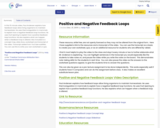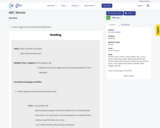9 Results

Developed by the Science Museum of Western Virginia, this educator outline was written for an in-museum program that addresses computational thinking. Teachers and students in grades 3-4 will expand knowledge of computer science algorithms and programming content while working through the activities "Flossbot" and "Edison Bot Activity".
*Edison bots are used for the second activity.
Key concepts include:
computer science
coding
programming
binary
computer
robot
loop
bug/ debug
- Subject:
- Computer Science
- Material Type:
- Activity/Lab
- Lesson
- Author:
- Science Museum of Western Virginia
- Date Added:
- 06/22/2020

This is a very brief introductory lesson using a game coded in java to introduce while loops and if and else if statements.
- Subject:
- Algorithms and Programming
- Material Type:
- Lesson Plan
- Author:
- Jude Raffeinner
- Date Added:
- 08/01/2021

In this 15 minute video, Paul Andersen explains how feedback loops allow living organisms to maintain homeostasis. He uses thermoregulation in mammals to explain how a negative feedback loop functions. He uses fruit ripening to explain how a positive feedback loop functions. He also explains what can happen when a feedback loop is altered.
Also included is a concept map, slide show, worksheet and transcript of the video.
Transcript added from YouTube subtitles. You can use this to write your own worksheet or quiz.
- Subject:
- Living Systems and Processes
- Science
- Material Type:
- Homework/Assignment
- Lecture
- Lecture Notes
- Teaching/Learning Strategy
- Visual Media
- Date Added:
- 12/01/2019

Developed by the Science Museum of Western Virginia, this educator outline is intended to assist in guiding middle school-aged students through various activities using the Rokit Smart robot kit. The Rokit Smart utilizes Arduino, a widely-used open-source environment for programming that enables users to create interactive electronic objects. Designed through modules, the activities can be grouped to fit after-school, summer camp, or other student enrichment needs.
- Subject:
- Algorithms and Programming
- Computer Science
- Material Type:
- Activity/Lab
- Author:
- Science Museum of Western Virginia
- Date Added:
- 10/06/2021

Developed by the Science Museum of Western Virginia, this educator outline is intended to assist in guiding middle school-aged students through various activities using the Rokit Smart robot kit. The Rokit Smart utilizes Arduino, a widely-used open-source environment for programming that enables users to create interactive electronic objects. Designed through modules, the activities can be grouped to fit after-school, summer camp, or other student enrichment needs.
- Subject:
- Algorithms and Programming
- Computer Science
- Material Type:
- Activity/Lab
- Author:
- Science Museum of Western Virginia
- Date Added:
- 10/06/2021

Developed by the Science Museum of Western Virginia, this educator outline is intended to assist in guiding middle school-aged students through various activities using the Rokit Smart robot kit. The Rokit Smart utilizes Arduino, a widely-used open-source environment for programming that enables users to create interactive electronic objects. Designed through modules, the activities can be grouped to fit after-school, summer camp, or other student enrichment needs.
- Subject:
- Algorithms and Programming
- Computer Science
- Material Type:
- Activity/Lab
- Author:
- Science Museum of Western Virginia
- Date Added:
- 10/06/2021

Developed by the Science Museum of Western Virginia, this educator outline is intended to assist in guiding middle school-aged students through various activities using the Rokit Smart robot kit. The Rokit Smart utilizes Arduino, a widely-used open-source environment for programming that enables users to create interactive electronic objects. Designed through modules, the activities can be grouped to fit after-school, summer camp, or other student enrichment needs. *Module 4 is meant to be done after Modules 1-3 are completed.
- Subject:
- Algorithms and Programming
- Computer Science
- Material Type:
- Activity/Lab
- Author:
- Science Museum of Western Virginia
- Date Added:
- 10/06/2021

In this lesson, the students in 3td grade will learn the basics of looping.
- Subject:
- Algorithms and Programming
- Material Type:
- Activity/Lab
- Author:
- May Stewart
- Date Added:
- 12/20/2022
